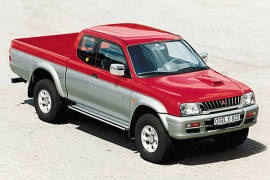Mitsubishi introduced the second generation of the L200 in 1995 and offered it in three cab versions, with the Crew-Cab positioned between the two-seat Single-Cab and the five-seat Double-Cab.
Sometimes, a contractor needed more workers for a job, but most of the time, he needed more loading area. In that situation, he wouldn’t choose a double cab, which was more expensive, nor a single cab since it didn’t have any rear seats. The Crew-cab offered a lower price than its four-door sibling, but it still had enough loading area for tools and materials.
Its design showed softer edges and curved lines over the front end and door panels. But it didn’t forget its origins and tried to be also a rugged, go-anywhere vehicle. Unlike other American pickups, the L200 didn’t have rear-hinged half-doors in the back; it only had two regular doors. Despite being an all-terrain vehicle, it showed smoother lines on the bodywork and curved panels.
Inside, the base version also offered a blue-collar interior, with cloth seats, cranked windows, and plastics hard and poorly finished. It could carry one metric ton and still didn’t complain about minimum wage or lunch break. The pop-out rear windows were more than enough to cool the cabin if the owner didn’t opt for an AC unit. But Mitsubishi offered the Warrior top-spec version on selected markets. That one was mainly for those who needed just a two-seat pickup with more room behind the seats for luggage and a bed where they could load a pair of bikes.
Under the hood, Mitsubishi installed a 2.5-liter turbo-diesel engine paired with a five-speed manual. Depending on the market, it was available with a 4x4 system with a transfer box and low-range gear.

























































